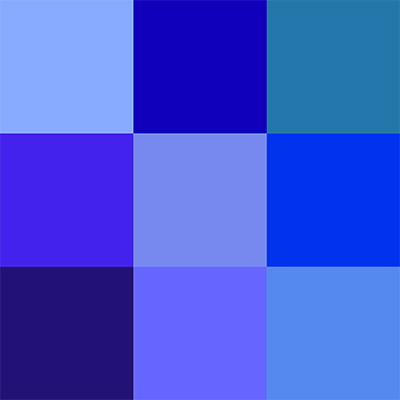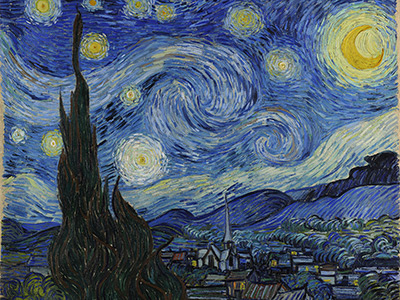Different swatches of Blue.
The color blue is the color of
trust and responsibility
VALUE AND MEANING

Blue has been used for art and decoration since ancient times. The semi-precious stone lapis lazuli, coming from mines inAfghanistan, was used in ancient Egypt for jewelry and ornament and later, in The Renaissance, to make the pigmentultramarine, the most expensive of all pigments. In the Middle Ages, cobalt blue was used to colour the stained glass windowsof cathedrals. Beginning in the 9th century, Chinese artists used cobalt to make fine blue and white porcelain. Blue dyes for clothing were made from woad in Europe and indigo in Asia and Africa. In 1828 a synthetic ultramarine pigment was developed, and synthetic blue dyes and pigments gradually replaced mineral pigments and vegetable dyes. Pierre-Auguste Renoir, Vincent van Gogh and other late 19th century painters used ultramarine and cobalt blue not just to depict nature, but to create moods and emotions. In the late 18th century and 19th century, blue became a popular colour for military uniforms and police uniforms. In the 20th century, because blue was commonly associated with harmony, it was chosen as the colour of the flags of the United Nations and the European Union. Toward the end of the 20th century, dark blue replaced dark grey as the most common colour for business suits; surveys showed that blue was the colour most associated with the masculine, just ahead of black, and was also the colour most associated with intelligence, knowledge, calm and concentration.
Surveys in the US and Europe show that blue is the colour most commonly associated with harmony, faithfulness, confidence, distance, infinity, the imagination, cold, and sometimes with sadness. In US and European public opinion polls it is the most popular colour, chosen by almost half of both men and women as their favourite colour.
THE IMPRESSIONIST PAINTERS

Blue expresses a sense of profundity in Vincent van Gogh's cosmic landscape, Starry Night
The invention of new synthetic pigments in the 18th and 19th centuries considerably brightened and expanded the palette of painters. J.M.W. Turner experimented with the new cobalt blue, and of the twenty colours most used by the Impressionists, twelve were new and synthetic colours, including cobalt blue, ultramarine and cerulean blue.
Another important influence on painting in the 19th century was the theory of complementary colours, developed by the French chemist Michel Eugene Chevreul in 1828 and published in 1839. He demonstrated that placing complementary colours, such as blue and yellow-orange or ultramarine and yellow, next to each other heightened the intensity of each colour "to the apogee of their tonality." In 1879 an American physicist, Ogden Rood, published a book charting the complementary colours of each colour in the spectrum. This principle of painting was used by Claude Monet in his Impression – Sunrise – Fog (1872), where he put a vivid blue next to a bright orange sun, (1872) and in Régate à Argenteuil (1872), where he painted an orange sun against blue water. The colours brighten each other. Renoir used the same contrast of cobalt blue water and an orange sun in Canotage sur la Seine (1879–1880). Both Monet and Renoir liked to use pure colours, without any blending.
Monet and the impressionists were among the first to observe that shadows were full of colour. In his La Gare Saint-Lazare, the grey smoke, vapour and dark shadows are actually composed of mixtures of bright pigment, including cobalt blue, cerulean blue, synthetic ultramarine, emerald green, Guillet green, chrome yellow, vermilion and ecarlate red. Blue was a favourite colour of the impressionist painters, who used it not just to depict nature but to create moods, feelings and atmospheres. Cobalt blue, a pigment of cobalt oxide-aluminium oxide, was a favourite of Auguste Renoir and Vincent van Gogh. It was similar to smalt, a pigment used for centuries to make blue glass, but it was much improved by the French chemist Louis Jacques Thénard, who introduced it in 1802. It was very stable but extremely expensive. Van Gogh wrote to his brother Theo, "'Cobalt [blue] is a divine colour and there is nothing so beautiful for putting atmosphere around things ..."
Van Gogh described to his brother Theo how he composed a sky: "The dark blue sky is spotted with clouds of an even darker blue than the fundamental blue of intense cobalt, and others of a lighter blue, like the bluish white of the Milky Way ... the sea was very dark ultramarine, the shore a sort of violet and of light red as I see it, and on the dunes, a few bushes of prussian blue."